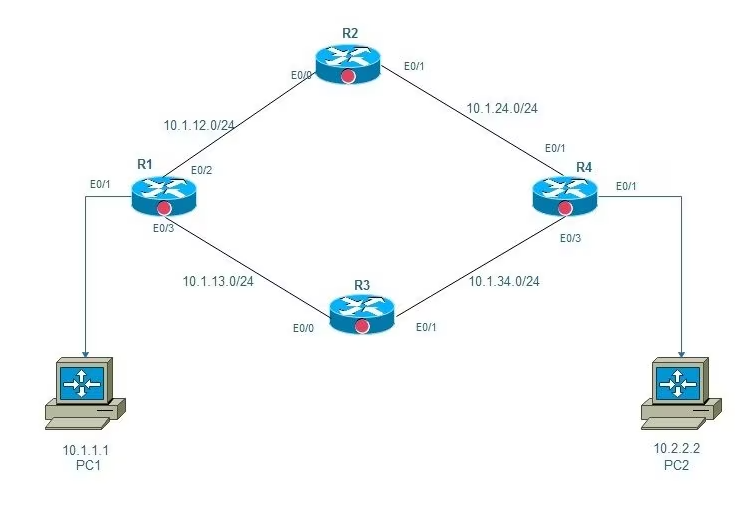OSPF Routing in the world of network technology is one of the technologies or innovations used for automatic routing protocols or can be called Dynamic Routing. The role of this tool is to maintain, manage, and distribute routing information between networks that can automatically or dynamically follow any network changes.
Before reading further, for those of you who want to know more about Netdata, you can contact us directly via the link below.
OSPF Routing is also known as the Autonomous System, which is a combination of several networks that are routing in nature and have the same methods and policies through Network settings where everything is managed and controlled by the network administrator. So that this tool will provide a solution to routing distribution errors, then OSPF.
Table of Contents
Get to know Routing and OSPF Routing
OSPF Routing is a protocol that is included in the IGP or Interior Gateway Protocol category which has Link State capabilities and the Djiksa Algorithm which is more efficient than other IGPs. In its operation, OSPF uses its own protocol, namely protocol 89.
With OSPF technology, it is designed to be efficient in sending route information updates. Which causes a network with many computers with more than 10 routers to use this OSPF technology.
How the OSPF Routing Protocol Works
To understand the OSPF routing protocol, you need to know how it works, namely:
- On each device the router creates a Link State Packet (LSP).
- Then this LSP is distributed to all neighbors using Link State Advertisement type 1 and determines DR and BDR in 1 AREA.
- Each router will calculate the shortest path to all neighbors based on routing costs.
- If there is a difference between the changes in the routing table, the router will send the LSP to the DR and BDR via the multicast address 224.0.0.6.
- LSP will be distributed by DR to other routers in 1 area so that other routers can recalculate the shortest path.
Media Used For OSPF Routing Protocol
In carrying out its role OSPF Routing is used by several media including:
-
Broadcast Multiaccess
OSPF routing works by sending multicast traffic in search of other neighbor routers. Broadcast multiaccess is often found on LAN networks such as token ring, ethernet, and FDDI.
-
Poin-To-Point
This technology only uses one router that is connected directly to other router devices. So that there is one neighbor router in one area. OSPF does not need to specify BDR and DR.
-
Point-To-Multipoint
The characteristics of this media have only one interface that connects to many routes. The series of networks listed below are considered point-to-point. These OS PF routing messages are replicated across the network to each point-to-point network that uses IP multicast.
-
Nonbroadcast Media
Physically this media is only a serial line which is often used in point to point types. But this type of media provides a connection that can connect to more than one network. The application of this NBMA does not require DR and BDR because this NBMA cannot forward broadcast information to points in the area.
OSPF Routing Has Some Special Characteristics
If you already understand how it works and the media that use this protocol, then we need to know the characteristics of this routing protocol, including:
- In the form of a link state routing protocol so that an overview of the network topology that each router has.
- Using hello packets to communicate or know the existence of other routers (neighbor routers).
- Routing updates are sent via multicast and only when there is a change in the network.
- Each routing update has an authentication feature.
- Including classless routing protocols.
- Can be split by area plan to work with hierarchical plans.
- Administrative distance value by default is 110.
- Use the cost for the metric, and the lowest cost will be the best metric.
- Has no hop count limitation.
Pros and Cons of OSPF Routing
For more details, the OSPF routing protocol certainly has advantages and disadvantages that can be understood, including:
Pros of OSPF Routing
There are several advantages of the OSPF routing protocol including:
- The process of updating information is better managed because of the hierarchical network concept.
- Using area-based network sections.
- The system updates regular routing information.
- Use cost as a metric
- Can save network bandwidth utilization.
- There is convergence so that all information can be known by all routers.
Disadvantages of OSPF Routing
For consideration, OSPF routing also has drawbacks, namely:
- Need to do planning to design the network.
- Requires careful planning in implementing the network.
- Requires a large database.
- Uses lots of resources.
Conclusion
OSPF routing above is indeed a protocol that is quite important in the development of quite innovative network technology. Above we can find out several ways of working, the advantages and disadvantages of this tool. how do you understand it well? If you like this article, you can read the various articles on the NetData page.
NetData is a company that provides technology-based services with the best service and quality, if you are interested in us you can contact us directly via this link or via our contact form here.
![]()


